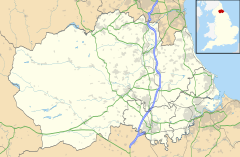Gainford, County Durham facts for kids
Quick facts for kids Gainford |
|
|---|---|
 Gainford Post Office |
|
| Population | 1,241 (including Denton, County Durham 2011) |
| OS grid reference | NZ168166 |
| Unitary authority | |
| Ceremonial county | |
| Region | |
| Country | England |
| Sovereign state | United Kingdom |
| Post town | Darlington |
| Postcode district | DL2 |
| Police | Durham |
| Fire | County Durham and Darlington |
| Ambulance | North East |
| EU Parliament | North East England |
| UK Parliament |
|
Gainford is a village in County Durham, England. It is located on the north side of the River Tees. You can find it about halfway between the towns of Barnard Castle and Darlington.
Contents
A Look Back in Time: Gainford's History
Early Days: Anglo-Saxons and Vikings
Long, long ago, Gainford was an important place for the Anglo-Saxons. It was part of a large area connected to Cuthbert of Lindisfarne, a famous saint. Later, Vikings came to live in this area.
Archaeologists have found cool Viking sculptures in Gainford. These sculptures show a mix of Anglo-Saxon and Viking art styles. You can even see some of them at the Open Treasure exhibition in Durham Cathedral.
Gainford Village Over the Years
In the 1800s, Gainford had its own spa, a place where people went for special water treatments. Today, the village is known for its beautiful, untouched village green. It also has a special old house called Gainford Hall, built in the Jacobean style. There's also a street called High Row with lovely Georgian-style buildings.
The village church, St Mary's, stands where an Anglo-Saxon monastery once was. This monastery was built by Bishop Ecgred of Lindisfarne way back in the early 800s.
The Edleston Spite House
In 1904, a family named Edleston owned land next to St. Mary's churchyard. They wanted to put up a monument for Joseph Edleston, who had worked at the church for 41 years. The church said no, claiming the churchyard was full. They suggested the family donate their land to the church instead.
Feeling upset, the family decided to build a house on their land. They added a 40-foot tall stone column right next to the churchyard. This column was so tall it stood over the trees. It even had a large V-shape pointing towards the church! This house is still standing today and people live in it. The column is still there, but the V-shape is gone.
Gainford's Unique Houses
The houses around the village green are mostly in the Georgian style. Some houses on the north and south sides are built from rough stones. In the past, these stone houses would have been covered with a smooth plaster. But now, people often remove the plaster to show the cool stonework underneath.
Most roofs in Gainford are made of red tiles called pantiles. They often have a line of flat, split stones along the edges. Some bigger buildings have blue slate roofs. This slate was probably brought to the village by train a long time ago. The oldest cottages have very steep roofs, which suggests they might have been thatched with heather in the past.
The Village Cross
At the western end of the village green, you'll see a stone cross on a square base. The base of the cross is thought to be very old, from the Middle Ages. However, the cross itself was made in Victorian times, in 1897.
This cross was put up to celebrate Queen Victoria's Diamond Jubilee. This was the 60th anniversary of her becoming queen. The cross was made by a local company, Isaac Charge and Son, from Gainford.
On one side of the cross, there's an inscription that says: In thankful commemoration of the sixtieth anniversary of the accession of Queen Victoria on June 20th 1897. This cross was re-erected and trees planted on the green by the inhabitants of Gainford. This means the villagers put up the cross and planted trees to remember the Queen's special anniversary.
Famous People from Gainford
Charles Bungay Fawcett (1883 – 1952) was a famous geographer. He is known as one of the people who helped start modern British geography studies. He also thought a lot about how to plan regions. Charles Fawcett went to school right here in Gainford.
Images for kids






